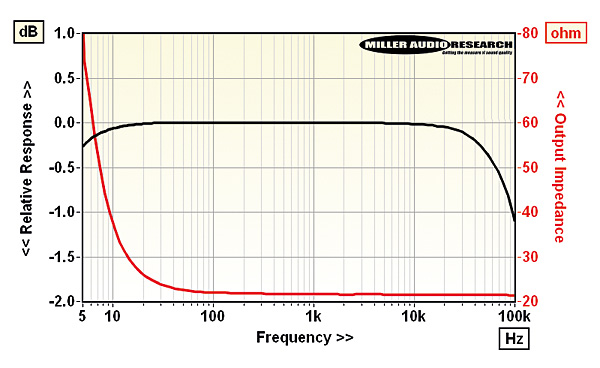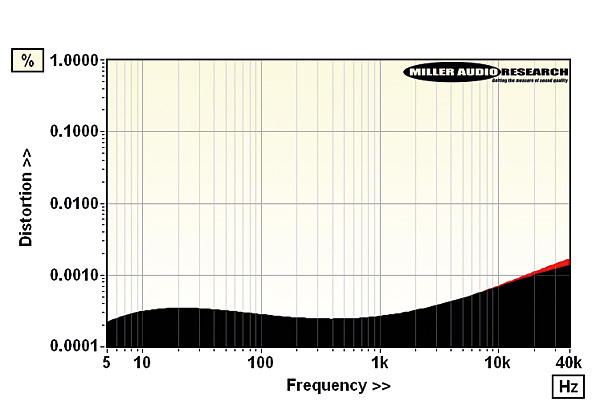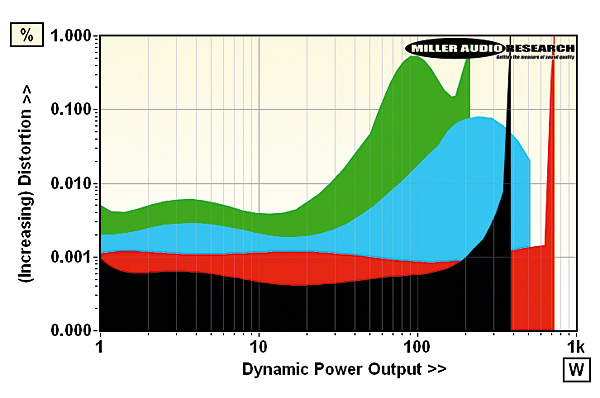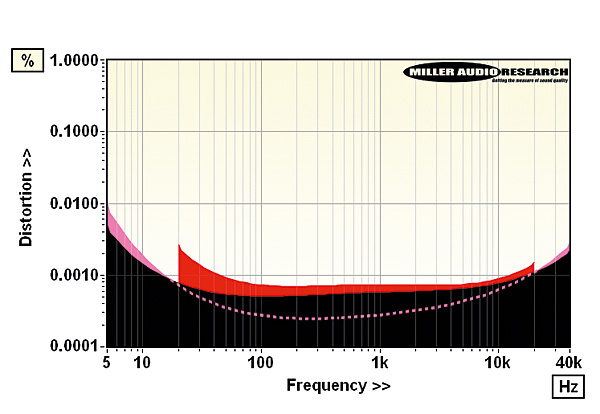Musical Fidelity Nu-Vista PRE/PAS & PSUs Pre/Power Amplifiers Lab Report
Musical Fidelity Nu-Vista Pre
The graphical metering that lights up the Nu-Vista PRE's fascia serves two functions, indicating both the overall gain of the preamp (the 'dB' figure adjacent to the indicated input) and the 'dBV' calibration of the input, not the preamp output. The former (gain) value is accurately represented with its maximum +7dB volume setting equivalent to +7.2dB (balanced in/out) or +13.2dB with the extra +6dB selected. The calibration of the volume setting is remarkable – accurate to within ±0.1dB over the top 97dB of its range (+7dB down to –90dB) and within ±0.2dB over the final 9dB down to the minimum –99dB setting. The graphical dBV metering is also accurate – the 0dBV setting equivalent to 1V input (RCA) and 2V (balanced XLR).
In practice the additional +6dB gain option has no impact on either distortion, response, separation (>100dB, 20Hz-20kHz) or output impedance but it does influence the A-wtd S/N ratio. Here the lower gain setting achieves a thunderous 99.6dB and the +6dB option a slightly lower 97.3dB (all re. 500mV in/0dBV out). Margins are extremely generous in the PRE with balanced inputs tolerating over 12V en route to delivering a maximum 39.0V output (re. <1% THD). This, in combination with the low ~22ohm source impedance, and response that's flat to within ±0.2dB from 6Hz-40kHz [see Graph 1, below], suggests the Nu-Vista PRE will drive any cable/power amp combination. Furthermore, as Musical Fidelity has demonstrated in previous Nuvistor products [HFN Nov '14, Dec '15 & Mar '18], the use of triode tubes in line/preamp stages need not presage high or even moderate distortion [see Graph 2]. Again, in practice, the Nu-Vista PRE incurs a mere 0.00015-0.001% (re. 0dBV, 20Hz-20kHz). PM


| Maximum output (<1% THD, 47kohm) | 39.0Vrms (Balanced) |
| Maximum input level (<1% THD) | >12Vrms (Balanced) |
| Output impedance (20Hz–20kHz) | 21.5-24.8ohm (Balanced) |
| Freq. response (20Hz–20kHz/100kHz) | +0.0dB to –0.05dB / –1.1dB |
| Input sensitivity (re. 0dBV) | 435mV (Balanced) |
| A-wtd S/N ratio (re. 0dBV) | 99.6dB / 97.3dB (+6dB gain) |
| Distortion (20Hz-20kHz re. 0dBV) | 0.00015–0.001% |
| Power consumption | 109W (1W standby) |
| Dimensions (WHD) / Weight (total) | 483x188x491mm / 47kg |
Musical Fidelity Nu-Vista Pas
Historically, the biggest amplifiers from Musical Fidelity have also posted 'big' power figures and, into 8 and 4ohm at least, the Nu-Vista PAS follows suit. However, while this latest nuvistor/bipolar hybrid amplifier marks a return to Musical Fidelity's familiar stomping ground, the low impedance/high current 'grunt' demonstrated by the Nu-Vista 800 [HFN Nov '14] is restrained here by what looks like over-cautious electronic protection. Let's compare the figures... Both the new Nu-Vista PAS and 'old' 800 are rated at 300W/8ohm and both (coincidentally?) deliver a full 2x330W/8ohm and 2x580W/4ohm. Under dynamic conditions too, the 800 and PAS offer a similar 370W/700W and 385W/730W, respectively, into 8 and 4ohm. Into lower loads, however, while the Nu-Vista 800 powered on to 1.30kW and 2.17kW (46.5A) into 2 and 1ohm loads at <1% THD, the Nu-Vista PAS is limited to just 575W/2ohm (17A) and 198W/1ohm [see Graph 1, below]. In practice it's unlikely the PAS will mute unless driving a really tough and insensitive loudspeaker really hard, but the design clearly has more under the bonnet...
Otherwise, the PAS's performance builds on the 800's with a lower distortion of just 0.00025-0.0011% versus 0.001-0.004% (re. 10W/20Hz-20kHz) and a wider A-wtd S/N ratio (94.1dB vs. 86.0dB re. 0dBW), although the PAS necessarily has lower overall gain (+23.5dB vs. +42.3dB). Interestingly both the 800 and PAS show a slight increase in THD at low frequencies from 0.0003%/1kHz to 0.0007%/20Hz and 0.01%/5Hz [see Graph 2]. Finally, the PAS's output impedance is lower (~0.02ohm vs. ~0.03ohm), the response slightly flatter with –1dB points at 2Hz-55kHz (vs. 6Hz-48kHz) and crosstalk reduced (–113dB vs. –99dB). PM


| Power output (<1% THD, 8/4ohm) | 330W / 580W |
| Dynamic power (<1% THD, 8/4/2/1ohm) | 385W / 732W / 575W / 198W |
| Output imp. (20Hz–20kHz/100kHz) | 0.019–0.07ohm / 0.58ohm |
| Freq. resp. (20Hz–20kHz/100kHz) | +0.0dB to –0.18dB/–2.4dB |
| Input sensitivity (for 0dBW/300W) | 186mV / 3220mV |
| A-wtd S/N ratio (re. 0dBW/300W) | 94.1dB / 118.9dB |
| Distortion (20Hz-20kHz, 10W/8ohm) | 0.00025–0.0011% |
| Power consumption (Idle/Rated o/p) | 140W / 975W (1W standby) |
| Dimensions (WHD) / Weight (total) | 483x188x475mm / 67kg |
| Prices (PRE/PAS inc. PSUs): £20,499/£21,999 |


















































